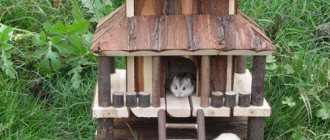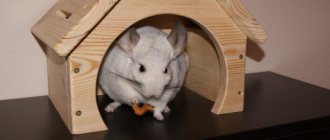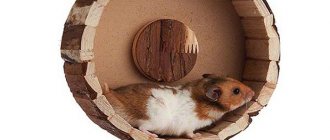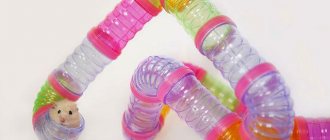Before getting a rodent, it is important to first take care of where it will live. However, this issue is easily resolved, because making a hamster cage with your own hands is quite possible.
We will analyze step-by-step instructions for creating a house for a small pet from various materials, and also study the basic requirements for such structures.
Requirements for cages for keeping rodents
Housing for comfortable living of hamsters has its own characteristics.
Size and shape
The main requirements for an animal's cage relate to its size. According to experts from different countries, keeping a hamster requires organizing a large space. At the same time, different zoologists call different numbers. But most researchers agree that a pet's cage should be at least 2900-6000 cm², and its height should be 30 cm or more.
Pet stores sell small housing for hamsters, but for a comfortable life for a rodent, it is better that the enclosure is approximately 70x80 cm or slightly smaller.
The most convenient cells are square and rectangular. A spherical-shaped home is more difficult to clean.
Distance between rods
If the hamster's place of residence consists of separate rods, the distance between them should be small. It depends on the size of the pet. The main task is to prevent the animal from getting out.
The distance between the rods should be small.
The smallest, dwarf breeds or cubs should live in housing with a size between the bars of no more than 5-6 mm.
For Syrian hamsters or larger individuals, the rods should be spaced no more than 10-12 mm apart.
Design features
A house for a rodent can be solid - made of wood, glass or plastic - or made of rods, gratings, nets.
Advantages of continuous housing:
- the animal is reliably protected from other pets living in the house - for example, cats;
- the hamster will not fall while climbing walls.
However, there are some disadvantages:
- odors accumulate faster;
- housing will have to be cleaned more often;
- a solid structure is less ventilated.
Advantages of a house made of twigs:
- the cage is well ventilated;
- The hamster’s housing is easy to clean;
- you can observe the actions of the animal.
The hamster's housing is convenient to clean, the cage is ventilated.
It is better when the bars are located horizontally so that the pet can climb them like a ladder. But it is desirable that the cage is not high, because... the animal may fall.
But you need to take into account that a hamster can chew through soft metal or swallow paint. It is better to buy an enclosure made of durable rods coated with a stainless steel compound. In addition, in this case, hamsters can climb walls that consist of horizontal rods and fall from a height. This may cause injury.
In addition to simple enclosures, they can be multi-story, modular, with shelves for climbing, etc.
In multi-storey cages, the area of each level must be no less than the previously specified dimensions. It is better to choose solid ceilings so that the animal cannot get injured. Each level is connected to the other using stairs or wide tunnels.
Material of manufacture
Solid structures are most often made of durable plastic. It must be non-toxic, because... the hamster may chew on protruding parts. Most often, housing for pets is made of acrylic, because... Thanks to its finely porous structure, it is easy to clean.
The main disadvantage of this material is the absorption of odors. It is difficult to eliminate this unpleasant phenomenon even with the help of modern means.
Some animal owners prefer to keep hamsters in a glass aquarium. This is a bad option because... such a place to keep an animal is poorly ventilated. To improve ventilation and prevent fogging of the walls, the width of the aquarium should be greater than the height.
A glass aquarium is poorly ventilated.
Some dwellings are made of wood. It should be remembered that a hamster can chew through its house. Its walls should be thick, made of hard rock.
There are combined products that are made from different types of materials.
The best material is considered to be nickel-plated metal, from which rods for homes are made. It is easy to wash and does not absorb odors. This habitat is well ventilated.
The tray is hygienic, even if it is made of plastic, since it is covered with a layer of filler of at least 5 cm.
However, cages with metal bars have a drawback: a lot of noise from the hamster's movements.
How many hamsters can live in one cage?
Small breeds of hamsters (except Djungarian) can be placed in one cage. Bergman's hamsters are considered the most social. But keeping several animals together will require more space than keeping one.
Installation of the second floor
If you plan to place several animals in a dwelling, you will need a second floor. In this case, one container can be located above another. In this case, it is necessary to add ventilation in the lower box. You can replace one wall with a grille.
If the animal lives alone, then the two floors can be connected by a special tunnel. Hamsters love all kinds of transitions. They can run from one box to another. This will expand the habitat for the animal, as well as install more diverse equipment. Plastic tunnels can be purchased at a pet store or made from bottles. In this case, you will need to cut off the neck and bottom of the plastic bottle.
Both ends must have the same diameter. Wrap the edges with electrical tape along the cut lines. Then one container needs to be inserted into another, and then connect the parts using electrical tape. It is important to ensure that the fastening is secure. Containers must be selected taking into account the size of the animals. For a Djungarian pet you will need a capacity of 1.5 liters, and for larger ones - 2 liters.
For tunnels, you can also choose corrugated plastic pipes, which are used when installing washbasins.
If you follow the instructions, you can create a cozy and practical cage for pets. In order for your home to last for a long time, you must carefully care for the product and follow safety precautions. The design should not contain parts with sharp corners or dangerous cuts. Only under such conditions will housing be beneficial and will please the hamster.
How to choose a cage for a hamster
To choose a suitable cage for a pet, you need to focus on the general requirements for the animal’s home and its breed. Small decorative hamsters can live in a small cage, but large individuals will need a more spacious home.
To prevent your hamster from becoming obese, you need to equip its habitat with accessories that allow it to actively move: a running wheel, stairs, tunnels.
For rest and sleep, a plastic house is installed inside the home.
Large hamsters need a spacious cage.
Djungarian hamsters
One of the most popular breeds is Djungarian hamsters. These are small and nimble animals. Even the largest male barely reaches 10 cm in length. Their weight is about 50 g. Among breeders they are considered a friendly breed.
Djungarian hamsters live only alone.
Syrian hamsters
Representatives of the Syrian breed are larger than their relatives. Their weight reaches 1245 g, and their height is 13.5 cm. Accordingly, their cage should be larger in size - at least 50-70 cm in length with a width of 40 cm and a height of at least 30 cm.
An interesting feature of hamsters of this breed is the ability to respond to a nickname. Only Syrian hamsters have this ability.
With good care, these hamsters can live up to 4 years. It is necessary to provide all the conditions for a comfortable stay for the animal and equip its home with devices that maintain its shape.
Top part
The lattice can consist of cells of different sizes. In plastic cages they are usually smaller, which negatively affects ventilation, and the odor accumulated inside from waste products and gradually deteriorating supplies can adversely affect the health of the animal.
The metal mesh is larger, which provides good air movement, but gives some small breeds (for example, Djungarian hamsters) the opportunity to escape.
The aquarium is the most reliable in this regard, but there is practically no ventilation in it.
The best commercial hamster cages
The retail chain offers a large assortment of ready-made cages for rodents. Many of them are equipped with devices for the full life of the animal: a feeder, a drinking bowl, a house for sleeping and means for outdoor games. They imitate the life of an animal in nature.
Savic Geneva A5068 60x29x44 cm
This is one of the best housing models for animals. Its dimensions are 60x29x44 cm. This two-story cage for hamsters is equipped with everything necessary: the set includes a drinking bowl, a feeder, and a wheel for games. The upper and lower floors are connected by a staircase along which the hamster can run and climb. It is easy to change the filling in the cage - the tray slides out without causing disturbance to the animal.
Savic Geneva A5068 60x29x44 cm is the best model for a hamster.
A variety of colors will allow you to fit the hamster’s housing into the interior of the room: there are pink, black, and blue models.
Triol 31003a 40x26x53 cm
This beautiful cage consists of 3 floors connected by tunnels. The housing arrangement is designed for animals leading an active lifestyle. Equipped with everything necessary - drinking bowl, feeder, wheel. There is a small house on the side so that the pet can rest in it.
But large individuals can get stuck in the tubes connecting the floors.
Therefore, the only drawback of this design is that it cannot be used for Syrian hamsters.
Ferplast Dragster 50x35x25 cm
Children will love this cage. It is made in the shape of a car and is divided into 2 levels by a plastic partition. The Ferplast Dragster hamster housing has everything you need - a feeder, a house, a wheel. There are holes for connecting additional modules. This unusual cage is designed specifically for children.
Ferplast Dragster 50x35x25 cm contains a feeder, a house and a wheel.
Credo 47x30x37cm
The product of this brand is liked by many owners of small rodents. There are many tunnels, labyrinths, and passages for the active life of the animal. The Kredo design includes 2 floors connected to each other by a labyrinth tube. The cage is made of metal rods with a special coating. There is a handle on top for moving the home.
Triol Studio 33x21x23
This cage is small in size, so it is best used for keeping small animals. However, her space is well equipped. Comes with everything you need. The design of the Triol product includes plastic side surfaces and a metal middle part made of rods. The small area of the cell is compensated by the presence of tunnels.
Triol Studio 33x21x23 is a small cage.
Kinds
Materials
Pet stores offer several options for hamster cages.
Made of metal rods. A good ventilated home in which the rodent feels quite comfortable. The inconvenience is that the noise the hamster makes can be clearly heard through the bars, and dirt always forms around. Filler and debris easily penetrate through the bars. The grill itself should be made of high-quality solid metal.
It is recommended to buy cages in which the second floor is made of plastic and reinforced with high quality. Try to avoid wooden elements in the cage, as wood absorbs unpleasant odors and also becomes a favorite material for grinding down the rodent's incisors.
How to make your own rodent cage
Pet owners who do not have the opportunity to purchase ready-made housing for their animal are thinking about how to make a hamster cage with their own hands. At home it is made from scrap materials.
From plastic containers
To make your own cage, you will need a plastic bottle with a capacity of 10 liters. It is placed on its side and in the upper part a marker is used to indicate the dimensions sufficient to allow a running wheel to be placed inside. Then carefully cut a hole with a knife. You can separate this part of the plastic bottle completely or leave it as a cap. Then you need to cut holes in it for ventilation.
Using a hot soldering iron, pierce the bottom of the bottle in the middle so that the wheel can be secured.
The filler is placed through the cut hole, a sleeping house, a feeder and a drinking bowl are installed on top.
For outdoor games, you can build a tunnel from several 5-liter plastic bottles connected to each other through cut holes (see photo):
On the side of each corridor you need to make a passage for the hamster. To create ventilation, all bottles are pierced with an awl in several places.
You can use a plastic container to create a cage.
From containers
In order to organize the hamster's living space, you can use a large plastic container with a lid measuring at least 60x40 cm, and preferably 80x60 cm. It is sold in a hardware store.
Large rectangular holes are cut out in the side and lid. They are covered with a mesh with a mesh size of no more than 1 cm², which must be secured with ties or screws. Filler is poured into the bottom of the container.
From the aquarium
A low and wide aquarium can be used as a temporary home for a hamster. But do not forget that glass does not allow air to pass through, so the aquarium is not suitable for keeping a hamster permanently.
From boxes
Making a cage for an animal out of boxes is inconvenient, since the hamster will quickly chew through it. It can only be considered as a temporary place for the animal to stay, for example during the cleaning period.
A hamster will quickly chew through a cardboard house.
Made of wood
It's easy to assemble a rodent cage from scraps of floorboards. To do this, 2 short pieces of 40 cm each and a long piece of 60 cm are placed on the edge, forming the perimeter of the future cage, and secured with wood screws, as shown in the video:
Then moisture-resistant chipboard is laid on top and also secured with screws.
Turning the structure over, make the second and third rows in the same way. They are connected by metal threshold strips. Glass is inserted as the front wall or a mesh is secured.
To improve ventilation, you need to drill several holes from different sides in the wooden walls of your home.
This homemade hamster cage meets the requirements for keeping animals.
Houses
Some rodents prefer to build "nests". But even in this case, you can install houses in the cage - plastic or wooden. They must have a removable roof and entrance. Windows are unnecessary - the animal can get stuck in them. In addition, light will enter through the windows, which will prevent the hamster from sleeping during the day.
The house itself should be quite spacious - rodents often store their food supplies there. Flexible bridges can be used as housing. They will resemble caves if they are well covered with substrate. You can also prepare the house with your own hands. An empty dried coconut is suitable for these purposes. You need to drill a larger hole in it and sand the edges.
How to connect two cells
Sometimes it becomes necessary to connect 2 cages: for example, to clean one of them or move an animal into a carrying bag. To do this, you can use tunnels and special adapters from the round hole of the tube to the square exit from the cage, which are sold in a pet store.
Two cells can be connected by tunnels.
But you can adapt homemade devices for transferring a hamster, using old corrugated pipes from a vacuum cleaner or plastic bottles for this purpose. The main condition is not to create sharp corners so that the animal cannot get hurt.
The simplest device uses a ladder made of twigs to move rodents between levels and a plastic bottle. Using wire cutters, remove part of the metal crossbars along the diameter of the future pipe to create a tunnel.
The bottom and neck of the bottle are cut off and connected to the second cage.
What else is needed for a hamster to be completely happy?
In addition to the mandatory attributes of the cage, some other little things are needed that will allow the hamster to feel cheerful and healthy. or a special closed bathing suit for rodents. This is necessary because hamsters cannot be washed with water. They bathe in fine, clean sand. This sand can be bought at a pet store and poured into a special bathing suit or just a deep bowl. Hamsters enjoy wallowing in the sand, and you will immediately notice an improvement in the condition of your pet's coat.
Setting up a hamster cage
For sleep and rest, a small house is placed inside the animal’s home. Mandatory accessories include a drinking bowl and a feeder. For motor activity of the animal, a running wheel is placed in the cage. All other toys and devices are installed at the request of the owner. But don't forget that hamsters love to make holes, dig, move and play.
Filler is poured onto the bottom of the cage to absorb moisture and odors.
Filler selection
Previously, when special litter for keeping hamsters was not sold, scraps of newspaper were used. However, such bedding contained printing ink, which was harmful to the animals.
Fine sawdust is the most suitable material for the cage.
The use of napkins and paper towels is allowed. However, they should not be dense or have sharp edges that pose a danger to the pet.
Do not use cotton wool or scraps of fabric, because their fibers can become wrapped around your hamster's legs and cause injury.
The most suitable qualities for the underlying layer are fine sawdust or corn husks. They absorb moisture well and do not concentrate odors. Pet stores sell these bulk materials, made specifically for filling trays in animal cages.
Containers for food and water
It is better to use a porcelain bowl or other heavy container as a feeder, because... the hamster can turn it over.
For the same reason, drinking bowls are most often placed outside the cage, leaving only the spout inside for drinking moisture. Pet stores offer nipple, ball and vacuum water devices. They are attached to the outside of the cage and will not take up space inside.
Accessories and toys
A rodent's leisure time should be varied. Pet stores have various devices for animal games and activities: houses, ropes, drums, balls. A hamster can climb stairs or chew on a mineral stone, and a fabric hammock will not only be an excellent toy for your pet, but also a decoration for the cage.
The rodent must have organized leisure time.
Rodent toilet
Some hamsters are so clean that they perform their natural needs in only one place. In this case, a small container is placed there to collect waste. Then you will have to clean the cage less often.
Required materials and tools
The simplest option is to make a rack from wood or thick plywood. These materials are easier to work with, although they have one drawback - hamsters will periodically gnaw on structural elements, since they need to grind down their front incisors. To minimize damage, you can make only the frame from wood, and use tempered glass, plastic or metal mesh as walls. It is especially important to pay attention to the design of the bottom. Untreated wood absorbs moisture and odors well, so it is more advisable to make it from laminated chipboard or plastic.
Did you know? Hamsters have cheek pouches into which they take in air and, due to this, float well on water.
If you decide to make several floors, the partitions between them should be strong, about 2 cm thick. If the rack is wide, you can take thicker material that will not sag during use. To securely fix joints and small parts, you will need construction glue, and if the house has opening hatches and doors. You need to purchase the appropriate fittings from a furniture store. In addition to materials, you need to prepare a set of tools. The simplest ones are a pencil, a ruler and a square. With their help, you will transfer the details of the drawing onto the material.
Next you will need:
- hacksaw;
- hammer;
- jigsaw;
- screwdriver;
- metal scissors;
- fasteners (nails, screws, metal corners, etc.).
How else can you equip a terrarium for a dwarf?
A homemade house for Djungarian hamsters may look something like the photo below. You can complement it with other accessories for a comfortable, fulfilling and energetic life for the animal. How to properly equip a cage for a dzhungarika so that it contains additional interior items that the rodent needs? You can equip your furry's apartment:
- Staircase-ramp. From multi-layer plywood or board, cut out a rectangle suitable for the hamster cage. Make 2 mm indentations across the workpiece. Using sandpaper, sand down any cut or rough edges or areas. The ladder is attached at an angle.
- Pipes. Do not throw away cardboard rolls left over from paper products . These hubs will provide hours of fun for your furry friend. We arrange them around the cage. You can put paper or treats inside the tubes, but it is also possible to leave them empty.
- Labyrinth. For such simple fun you will need a variety of cardboard boxes for chips, tea, baking sleeves, etc., thin tubes or foil tubes. We cut holes in different places in the containers and connect them together using ready-made thin bushings or homemade pipes.
We attach the boxes so that the end result is a labyrinth. To get your baby interested in a new toy, we place treats in the “rooms” .
- Toilet. It is worth finding a suitable container made of durable plastic, always with a lid. We make a hole in the side of the vessel, stepping back about 2 cm from the edge. Use sandpaper to smooth out all the irregularities. We install the toilet in the cage with the lid down and fill it with filler.
Don't forget to attach a hamster wheel to the cage. These rodents are very active!
What should be present in the home
In any home, bedding must be laid at the bottom. Its depth is at least 5 cm. Hamsters like to make small holes and tunnels from their bedding, therefore, there should be enough material for construction.
The purpose of the litter is to absorb moisture and retain aromas. The peculiarity of urea as a substance is that it does not smell when fresh. But after a day, microorganisms begin to develop in it, which give a specific smell. A good, high-quality litter should smell neutral within 2–3 days of use. If this is not the case, it’s time to look for another material for bedding.
Important! Be sure to freeze the bedding for 48 hours to kill any potential pests before placing it in your hamster's cage.
Also in the house there should be a feeding trough, a drinking bowl with water, and a salt or chalk stone for grinding down teeth. Toys are a great addition to any hamster's enclosure. Some people like to climb small ropes, many will rummage through a toy house, and others prefer to roll around the house in a walking ball.
Main groups of toys:
- Running wheel. Most hamsters love to run on a wheel. This is the most popular toy for these cute creatures. It should have a solid surface without cracks and be of a size appropriate to the size of the pet. Don’t be surprised, but judging the size by eye, the hamster will not use the small wheel.
- Chew toys. This includes anything that can be chewed - tree branches, pieces of cardboard, rings and rubber balls. The pet will find a use even for an ordinary roll of toilet paper and will happily shred it.
- Ladders and structures that can be climbed. If the store does not have such toys for hamsters, then those sold for birds are also suitable for them.
Don't buy many items at once. Add one toy at a time and study the reaction. Pets often show individuality in this matter. As for the cage, create one that you can make as safe as possible for your furry rodent.
Was this article helpful? Yes No Has already helped 3 times
Vintage basket
Here we are dealing with a representative design in the style of modern rural fashion. Best suited for lovers of cycling or short distance travel on scooters. The basket itself is woven from flexible willow and equipped with an openwork wire lid, which prevents the cat from wanting to get out while moving. At the first glance at such a carrier, one is reminded of idyllic pictures from centuries ago, when food from the market was transported in a similar way on bicycles. The entire structure is conveniently attached to the steering wheel using leather straps and does not require much time for preparation.
The advantage of the option under consideration is, of course, its original design and originality. The downside is limited functionality. Although, if desired, the basket can be used for its intended purpose.
Price – 1,128 – 1,708 rubles.











